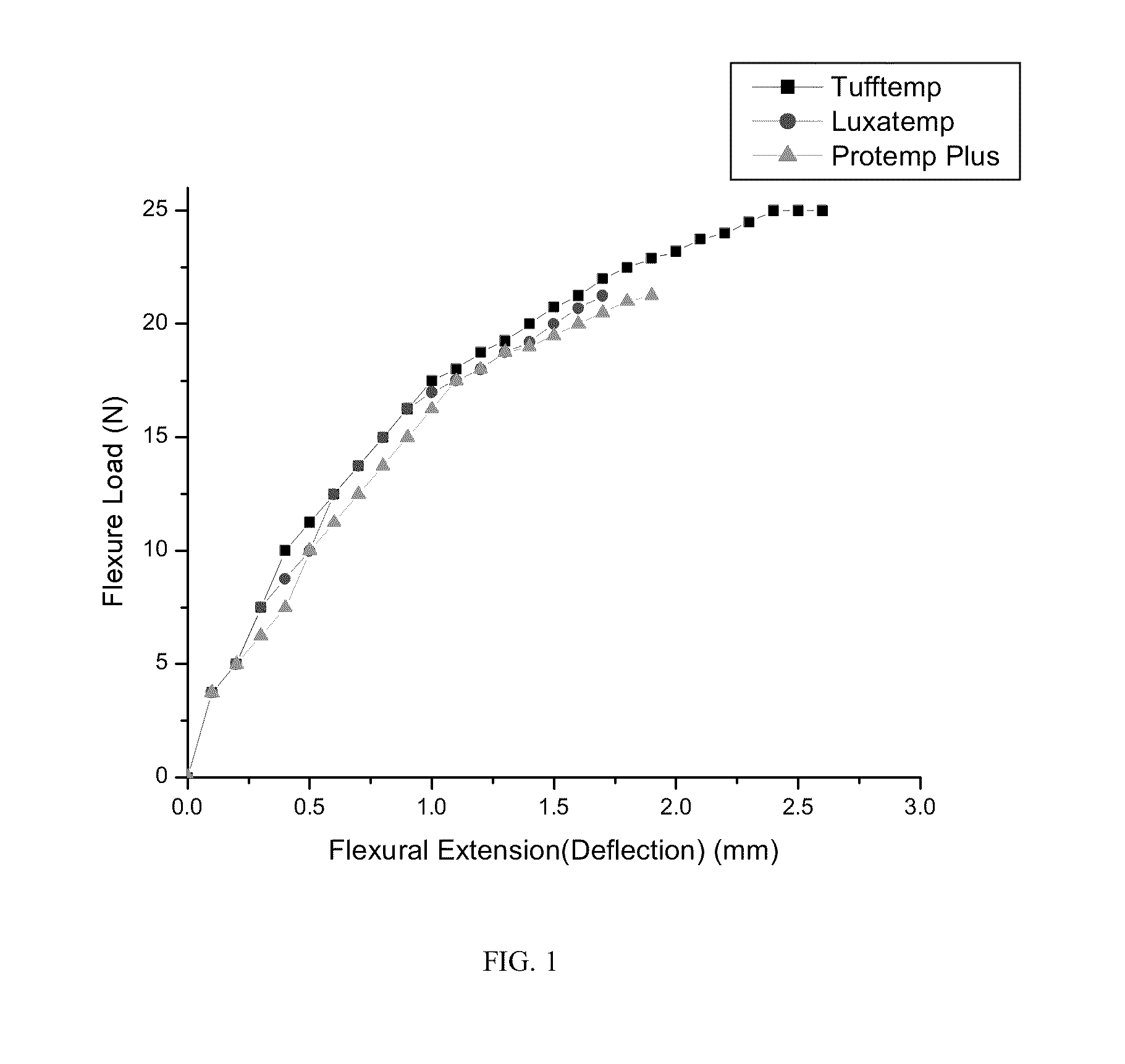Radically Curable Urethane Dimethacrylates and Compositions Thereof for Tougher Dental Prosthetics
a technology of polyurethane dimethacrylate and composition, which is applied in the field of radical curable polyurethane dimethacrylate prepolymer, can solve the problems of cracking resin, strong and objectionable odor of pmma products, and inability to withstand high temperature, so as to maintain the aesthetics required of dental materials, the effect of superior and synergistic properties of hardness, toughness and flexural strength
- Summary
- Abstract
- Description
- Claims
- Application Information
AI Technical Summary
Benefits of technology
Problems solved by technology
Method used
Image
Examples
example 1
[0072]Accelerator side:
IngredientPercentUrethane dimethacrylate27.0Polyurethane dimethacrylate0.0with Flexible Unitspolyether dimethacrylate7.5alkyl dimethacrylate26.5Glass filler33.0amorphous silica5.2photoinitiator0.14amine0.75BHT0.001
Catalyst side:
IngredientPercentUrethane dimethacrylate52.3Polyethylene glycol dimethacrylate7.7Glass filler34.0amorphous silica5.4benzoyl peroxide0.73BHT0.035
[0073]Mixing equal parts of accelerator and catalyst caused the material to cure to a hard resin. The resin mix can also undergo visible light cure polymerization.
Properties:
[0074]Flexural strength (Mpa): 71.2
Deflection-at-break (mm): 1.8
[0075]Compressive strength (Mpa): 300
Results:
[0076]Example 1 demonstrates a polymerized composite material without inclusion of polyurethane dimethacrylate prepolymers with flexible units. Although this example has excellent flexural and compressive strength, it is extremely brittle, as reflected in its low deflection-at-break value. This brittleness results in ...
example 2
[0077]Accelerator side:
IngredientPercentUrethane dimethacrylate27.0Polyurethane dimethacrylate0.0with Flexible Unitspolyether dimethacrylate26.5alkyl dimethacrylate7.5Glass filler33.0amorphous silica5.2photoinitiator0.14amine0.75BHT0.001
Catalyst side:
IngredientPercentUrethane dimethacrylate52.3Polyethylene glycol dimethacrylate7.7Glass filler34.0amorphous silica5.4benzoyl peroxide0.73BHT0.035
[0078]Mixing equal parts of accelerator and catalyst caused the material to cure to a hard resin. The resin mix can also undergo visible light cure polymerization.
Properties:
[0079]Flexural strength (Mpa): 43.3
Deflection-at-break (mm): 3.4
[0080]Compressive strength (Mpa): 226
Results:
[0081]Example 2 demonstrates another polymerized composite material formulation without inclusion of polyurethane dimethacrylate prepolymers with flexible units. In this particular formulation, it can be seen that although the composite material exhibits excellent deflection-at-break, its flexural strength is poor.
example 3
[0082]Accelerator side:
IngredientPercentUrethane dimethacrylate27.0Polyurethane dimethacrylate0.0with Flexible Unitspolyether dimethacrylate7.2alkyl dimethacrylate7.5Polybutadiene dimethacrylate19.2Glass filler33.0amorphous silica5.2photoinitiator0.14amine0.75BHT0.001
Catalyst side:
IngredientPercentUrethane dimethacrylate52.3Polyethylene glycol dimethacrylate7.7Glass filler34.0amorphous silica5.4benzoyl peroxide0.73BHT0.035
[0083]Mixing equal parts of accelerator and catalyst caused the material to cure to a hard resin. The resin mix can also undergo visible light cure polymerization.
Properties:
[0084]Flexural strength (Mpa): 58.5
Deflection-at-break (mm): 1.8
[0085]Compressive strength (Mpa): 186
Results:
[0086]Example 3 demonstrates yet another polymerized composite material formulation without inclusion of polyurethane dimethacrylate prepolymers with flexible units. In this particular formulation, neither the flexural strength nor deflection-at-break properties are optimal for dental ap...
PUM
| Property | Measurement | Unit |
|---|---|---|
| wavelengths | aaaaa | aaaaa |
| temperature | aaaaa | aaaaa |
| temperature | aaaaa | aaaaa |
Abstract
Description
Claims
Application Information
 Login to View More
Login to View More - R&D
- Intellectual Property
- Life Sciences
- Materials
- Tech Scout
- Unparalleled Data Quality
- Higher Quality Content
- 60% Fewer Hallucinations
Browse by: Latest US Patents, China's latest patents, Technical Efficacy Thesaurus, Application Domain, Technology Topic, Popular Technical Reports.
© 2025 PatSnap. All rights reserved.Legal|Privacy policy|Modern Slavery Act Transparency Statement|Sitemap|About US| Contact US: help@patsnap.com



